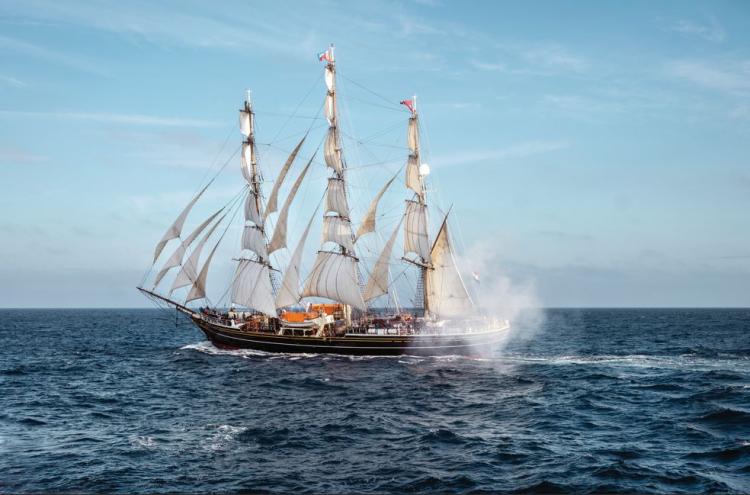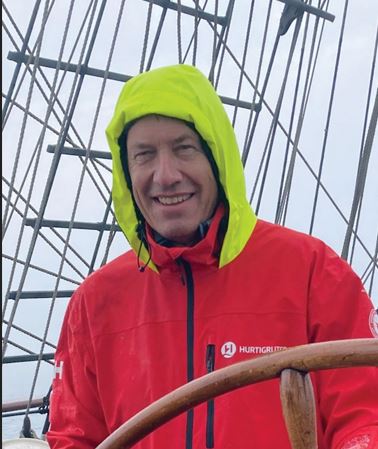Novice Tall Ship Sailors Learn the Ropes Sailing Across the Atlantic
This summer, my wife and I joined the amazing clipper ship, Stad Amsterdam, on the last phase of the 2023-2025 World Tour, from Boston to the Azores.
Stad Amsterdam, designed by the renowned Dutch Dykstra Naval Architects, was first presented to the public at the 2000 edition of the SAIL Amsterdam tall ship parade. Later, in 2001, she won the Cutty Sark Tall Ships’ Race in northern Europe. The ship is a modern extreme clipper in historical perspective, combining the best qualities of clippers of the past and built with modern techniques but with a classic look and feel.

On ocean crossings the ship carries up to 28 passengers and 30 professional crew members. Passengers have the option to participate in watches and to work alongside the crew with sail handling, mast climbing(!), steering, navigation, lookouts, and maintenance chores—plenty for a ship this size. Meals are shared with passengers and crew in the long room. Passenger cabins are nicely apportioned with comfortable bunks, desk, shower and toilet cabin, generous LED lighting, and AC/ventilation (thanks to two large dieselpowered generators). It is a unique sailing experience: below deck with 21st-century comforts; above deck sending us back 150-plus years.
On June 30, as the sun set on the Boston skyline, we set sails, ready for adventure with destination Ponta Delgada on the island of San Miguel, some 2300 nautical miles ahead. The initial plan was an easterly rhumb-line heading, but after evaluating the forecasted weather pattern, the captain decided on a northerly great-circle route to increase the odds of staying with the wind.
As such, we sailed across near the southern tip of the Grands Banks, off Newfoundland, a mere 30 miles north of the Titanic, and experienced the proverbial foggy conditions.
The decision to alter route paid off. The next four to six days were beam to close reach, full sails, sunny and dry conditions with 15 to 20-plus knots of southerly breeze pushing the boat speed up to 13 knots, helped along by the Gulfstream. We were steadily eating away at the remaining nautical miles to San Miguel, and as it turned out later, the reward for the northerly route and keeping up the boat speed was sweet.
Stad Amsterdam’s length overall is 255 feet, with a beam of 35 feet and draft of 16 feet. Her main mast peaks 152 feet above the water with the foremast and mizzen mast slightly shorter. She carries 14 square sails, five staysails, four flying jibs, and an aft “spanker” sail: 24,000 square feet of sail area. In lighter winds, she can also fly “stun sails” off the square sail yards.

A clipper ship this size is in a completely different league from our regular sailboats. A square sail has a halyard, bracing lines, downhaul and “gear” (sheets, bunt, and leach lines), about six to eight lines total per sail. All lines are led to the classic “pin rails” along the port/starboard sides and around the masts, summing up almost eight miles of lines. Add the staysails and jibs, and you end up with well over 200 lines and pins, and they are not labelled!! However, there is an orderly system to these seemingly endless rows of pins as the crew explained to us at each watch where sails were either dowsed, raised or trimmed to maintain optimal boat speed and steering.
At the end of the two-week crossing I still struggled to find the correct pins without crew supervision, for say, “the bracing lines for the mizzen topgallant sail,” especially in the dark night watch. I felt better knowing that it typically takes a new deckhand about three months, full-time, to master every line. Most of the line pulling on a square rigger is done by hand, many hands, as we line up four, five, or six people and pull in unison with a “two-six, two-six” battle-cry until the crew says “hold” and “belay” onto the pin and neatly coil the lines on deck and hang them back onto the pin rail.
On day 10, excitement and anticipation began to spread as we approached the westerly Azores Islands. First, it so happened that another similar size square rigger, the Norwegian Statsraad Lehmkuhl, was departing the Azores and heading straight towards us. The Lehmkuhl, part of the “One Ocean” program for science and research, was headed north to Nuuk, Greenland, before preparing for a long Northwest passage. We managed to pass one another less than 400 yards apart in the early evening on July 10, two classic square rig ships, on the high seas in the middle of the Atlantic Ocean, unplanned and timed by coincidence. An experience not soon to forget.

That same evening, the captain announced that because we had kept up the average boat speed, we were estimated to be two days ahead of schedule and that the plan was now to berth the ship in Horta on the island of Faial and spend a day and a half before the last leg to Ponta Delgada. Horta is the bluewater sailors’ Mecca, a convenient pit-stop as they cross the Atlantic at this latitude on their way to destinations in Europe.
There is the famous “Peter’s Café” with the signature gin and tonic, the gin only produced and sold on this island, and the characteristic murals on the harbor seawalls painted by sailors during their visit.
We departed Horta and set course for Ponta Delgada, about 155 miles southeast. The weather forecast was sunny, with light air but on the nose, and the captain decided to motor to abide by the official schedule. Excitement rose again when he announced in the early afternoon that the “blue pool” would be opened for swimming.
With the engine turned off, ship drifting in the light breeze, starboard side access platform lowered, gangway set from deck to platform just above the water, we jumped into the (very) deep and clear blue ocean, under warm sunny skies, in between the islands of Pico and San Jorge. It doesn’t get much better than that!
In the morning of July 14, we entered the harbor at Ponta Delgada, San Miguel. After spending the day in the town, a full barbeque farewell dinner was served on the main deck with crew and passengers reflecting on the experience of a special ocean crossing. The next morning, we disembarked, everyone scattering with different itineraries.
My wife and I spent a few days on the island, driving around among green lush pastures, with the ever-present magnificent hydrangea flowers and their dominant colors densely lining the roadsides and hills, the volcanic caldera lakes, quaint towns, and breathtaking ocean views at every turn, before flying back to the East Coast. It took less than a day to arrive physically back home in Baltimore, yet the spirit was still behind somewhere in the Azores.
What an unforgettable experience and a joy to work alongside and learn from captain and crew. These young men and women have energy, discipline, knowledge, and a passion for tall ship sailing and all the work that comes with it, not to mention their patience and hospitality towards us passengers, novice “tall ship sailors.” We would do it all over again tomorrow.
By Per Struck
Find more offshore sailing stories.




